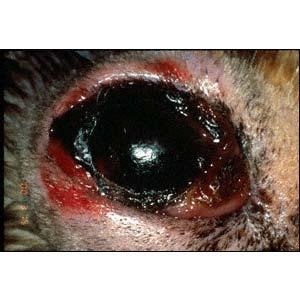
Cats
Optic neuritis is inflammation of the nerve that leads from the retina of the eye to the brain. Inflammation of this nerve interferes with normal function of the eye by preventing retinal information from reaching the brain. There is one optic nerve for each eye, and optic neuritis may involve one or both of the nerves. If both nerves are affected, then the animal is usually blind. The onset of blindness is usually sudden with optic neuritis.
Inflammation of the optic nerves may be associated with inflammation of the retina, inflammation of the brain, or may involve only the nerves themselves. Causes of optic neuritis in the cat include viral infections (feline infectious peritonitis), protozoal infections (toxoplasmosis), and fungal infections (cryptococcosis).
Immune diseases associated with feline leukemia and feline immunodeficiency virus, leukemias and lymphoma tumors, some forms of meningitis, and certain systemic diseases may also cause optic neuritis. In some cases of optic neuritis, the cause is never discovered and these are called "idiopathic" forms.
The optic nerve may be inflamed along its entire length from the retina to the brain, or only a portion of the nerve may be affected. When the beginning of the nerve is inflamed, this inflammation is visible by examining the retina. When the nerve behind the eye is inflamed, the retina may appear normal.
Optic neuritis can sometimes be difficult to diagnose. Tests may include the following:
When treating optic neuritis, be sure to follow precisely the medication instructions provided by your veterinarian. Repeated follow-up examinations are important to monitor response to therapy and to detect any worsening of the disease. Some cats respond well to treatment and regain their vision, while others remain blind. Optic neuritis is considered a serious condition and may represent a life-threatening illness.
There are no preventative measures available for optic neuritis. Early intervention and treatment may prevent other neurologic signs from developing.
 Anaphylaxis in Cats
Anaphylaxis in Cats Also known as allergic shock, anaphylasi
Anaphylaxis in Cats
Anaphylaxis in Cats Also known as allergic shock, anaphylasi
 Feline Epilepsy Symptoms and Treatment
If you
Feline Epilepsy Symptoms and Treatment
If you
 Top 5 Cat Urinary Tract Infection Home Remedies
Cat ur
Top 5 Cat Urinary Tract Infection Home Remedies
Cat ur
 Pregnant Cats With Fleas and Worms – How To Treat Safely?
When y
Pregnant Cats With Fleas and Worms – How To Treat Safely?
When y
 Ocular (Eye) Pain and Squinting in Cats
Ocular (Eye) Pain and Squinting in Cats
Ocular (Eye) Pain and Squinting in Cats
Ocular (Eye) Pain and Squinting in Cats
Copyright © 2005-2016 Pet Information All Rights Reserved
Contact us: www162date@outlook.com